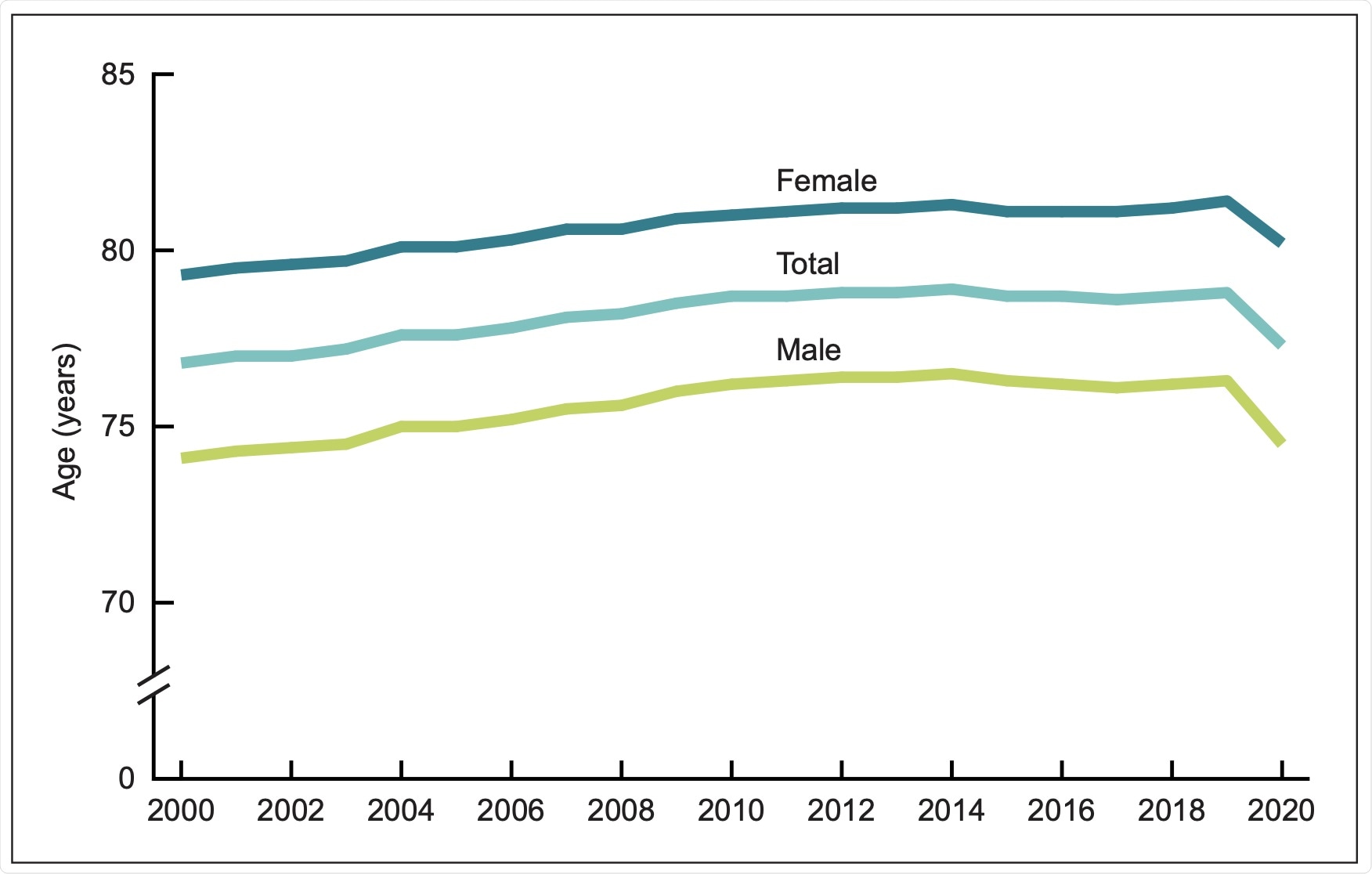New preliminary data from the United States Centers for Disease Control and Prevention (CDC) suggests that average life expectancy in the United States fell by 1.5 years over 2020. This staggering decline has been tied primarily to the high rate of coronavirus disease 2019 (COVID-19) mortalities that the country has experienced over the course of the pandemic. Since COVID-19 first reached the U.S., over 34.21 million cases and over 609,823 COVID-19-related deaths have been confirmed nationwide – currently the highest national toll in the world on both counts.
The study reports that the average life expectancy for Americans had declined from 78.8 years in 2019 to 77.3 years in 2020. The data suggests that 73.8% of that decline is tied to COVID-19-related deaths. "U.S. life expectancy at birth for 2020, based on nearly final data, was 77.3 years, the lowest it has been since 2003," wrote the CDC researchers in their report.
 Study: Provisional Life Expectancy Estimates for 2020. Image Credit: Hyejin Kang / Shutterstock.com
Study: Provisional Life Expectancy Estimates for 2020. Image Credit: Hyejin Kang / Shutterstock.com
How the study was conducted
The report’s findings are based on provisional data for the year 2020 gathered by the National Center for Health Statistics (NCHS), a public health surveillance organization that processes and disseminates death and birth records for the entire country. Because the study was based on this ever-evolving data source, then, some deaths or births were not incorporated into the dataset rendering its findings preliminary.
The three racial and ethnic groups that were included in this study included Hispanic, non-Hispanic Black, and non-Hispanic White populations, as these three groups constitute more than 90% of the U.S. population. Estimates for other ethnic groups residing in the United States such as the American Indian and Alaska Native (AIAN), Asian, and Native Hawaiian populations to name a few, were not included in the current study due to a lack of accurate information available from death certificates.
Life expectancy declines in the U.S.
Between 2010 and 2018, the United States experienced a small increase of 0.08 years in their life expectancy rates. However, between 2019 and 2020, the researchers found that life expectancy at birth decreased by about 1.5 years from 78.8 to 77.3 years.
In terms of gender, men in the United States experienced a larger decrease in their overall life expectancy rates as compared to women in both absolute and relative terms. More specifically, the estimated life expectancy for men was 74.5 years in 2020, which was 1.8 years less than that which was reported in 2019. Women also experienced a decline in their life expectancy rates between 2019 and 2020 from 81.4 years to 80.2 years, respectively.
 Life expectancy at birth, by sex: United States, 2000–2020.
Life expectancy at birth, by sex: United States, 2000–2020.
Additional disparities were identified in the Black population in the United States, in which life expectancy rates decreased by 2.9 years between 2019 and 2020. In fact, the reduction in life expectancy rates in the Black population was 2.4 times greater than the decrease that was recorded in the White population of 1.2 years.
In 2020, Black men were found to have a life expectancy of only 67.73 years, which was 3.56 years less than that which was recorded in 2018. The BMJ reports that Black women also experienced a greater reduction in their life expectancy rates of 2.65 years as compared to the entire U.S. population.
Hispanic individuals experienced an even larger reduction in their life expectancy rates of 3.88 years, which was 2.9 times higher than the reduction reported for White people living in the U.S. The life expectancy estimates for Hispanic men were also much lower than Hispanic women, with reductions of 3.7 years and 2.0 years, respectively, reported from 2019 to 2020.
 Life expectancy at birth, by Hispanic origin and race: United States, 2019 and 2020.
Life expectancy at birth, by Hispanic origin and race: United States, 2019 and 2020.
How life expectancy in the U.S. compares to other nations
In a study recently published in The BMJ, life expectancy estimates in the U.S. were also compared to 16 other high-income countries, where only sex aggregates were available. The peer countries included Austria, Belgium, Denmark, Finland, France, Israel, Netherlands, New Zealand, Norway, South Korea, Portugal, Spain, Sweden, Switzerland, Taiwan, and the United Kingdom.
As compared to other high-income countries, the United States was already at a disadvantage at the beginning of the current decade, as their life expectancy estimates were 1.88 years less than peer countries. This deficit in life expectancy continued to increase over the course of the decade to 3.05 years in 2018.
Between 2018 and 2020, the life expectancy gap in the U.S. as compared to peer countries grew substantially to 4.69 years. Furthermore, the decrease in life expectancy rates reported between 2018 and 2020 was 8.5 times greater than the rates that were reported in peer countries. In fact, the drop in life expectancy reported in the United States between 2018 and 2020 was the largest decline reported in this nation since 1943.
While the six nations of Denmark, Finland, New Zealand, Norway, South Korea, and Taiwan all reported increases in their life expectancy between 2018 and 2020, the 10 other nations included in this study reported reductions in their life expectancy estimates within the range of 0.12 years to 1.09 years.
Taken together, none of the reductions in life expectancy rates of other peer high-income countries came close to that which was reported in the U.S.
The benefit of calculating life expectancy
In general, life expectancy estimates are used to summarize a population’s mortality rate at a given point in time. While life expectancy estimates are not used to predict mortality rates for individuals who are alive today, they are instead used to provide information on the current mortality rates of a nation. Importantly, during the current COVID-19 pandemic, life expectancy rates assist in identifying which people or places have been most affected by the pandemic.
The COVID-19 pandemic brought public attention to systemic inequalities in health, wealth, and wellbeing and how these systems often disadvantage people of color while unfairly giving advantages to White people, particularly in the United States. For example, although life expectancy for the Black population within the United States has been consistently lower than that of the White population, this gap had been narrowing over the course of the past three decades. However, between 2019 and 2020, the life expectancy advantage of White people in the United States over Black people rose by 41.5%.
In 2019, the Hispanic population previously had a mortality advantage of 3.0 years as compared to the non-Hispanic White population. However, this gap narrowed significantly in 2020 to 1.2 years. Therefore, the narrowing in the gaps reported between White Americans and both Hispanic and non-Hispanic Black Americans demonstrates worsening health and mortality outcomes for these populations.
Journal references:
- Arias, E., Tejada-Vera, B., Ahmad, F. A., & Kochanek, K. D. (2021). Provisional Life Expectancy Estimates for 2020. https://www.cdc.gov/nchs/data/vsrr/vsrr015-508.pdf
- Woolf, S. H., Masters, R. K., & Aron, L. Y. (2021). Effect of the covid-19 pandemic in 2020 on life expectancy across populations in the USA and other high income countries: simulations of provisional mortality data. BMJ 373,doi:10.1136/bmj.n1343. https://www.bmj.com/content/373/bmj.n1343.